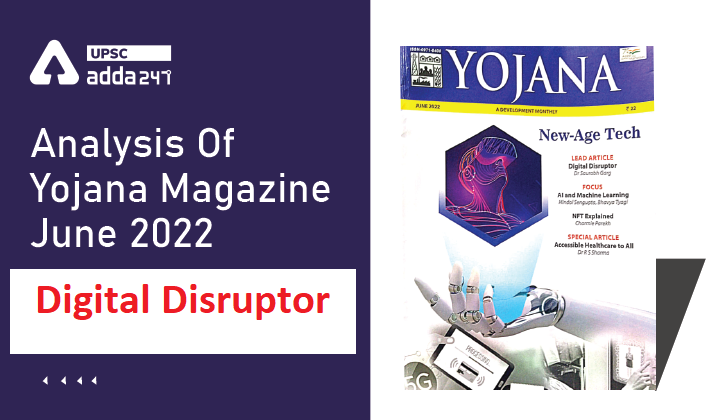Table of Contents
Yojana Magazine is a very important and indispensable source for UPSC Civil Services Exam Preparation. Here, we come with ”Analysis Of Yojana Magazine” which covers the monthly Yojana Magazine keeping in mind the demand of UPSC, particularly from the topics of important government schemes.
In ”Analysis Of Yojana Magazine,” we cover each and every topic of Yojana Magazine and provide an easy-to-understand gist.
Introduction
The economic and financial landscape are being revolutionised by rapid breakthroughs in technology, which more often than not are disruptive with immense long-term potential to benefit society at large.
What is a Digital Disruptor?
- Digital disruptor describes the change that happens when new digital technologies, services, capabilities and governance models affect and change the value of the existing services.
- Generally, digital disruption happens after a digital innovation, such as big data, machine learning (ML), internet of things (IoT)
- It is often confused with the term disruptive technology.
Why do we need effective digital technology?
- Effectively governing digital technologies is an urgent necessity in a world interconnected by and reliant on information and communications technologies (ICT), for both economic and social exchange.
- Right now, the numerous failures of governance – in terms of cybersecurity, privacy, consumer protection, antitrust and other legal and regulatory measures – have significantly destabilized institutions around the world.
- Even more importantly, these erosions of institutional capacity and credibility threaten to destabilize the functioning of democracy itself.
- In order to save democracy from our own digital tools, we need to adopt a new model of governing digitally – public leaders must take a systemic approach to these problems and collaborate widely and effectively to meet these challenges.
Some of the Broad Domain Areas with respect to Technology
AI and Machine Learning
AI technologies provide a plethora of opportunities to complement human intelligence and combat socio-economic issues.
Quantum Computing
Applications in secure communication, disaster management through better prediction, computing, simulation, chemistry, healthcare, cryptography, imaging, etc.
Semiconductor Technology including Semiconductor Nanotechnology
Aim to give a major push to the hardware industry by eliminating boundaries between digital and physical world.
Smart Manufacturing
Use of Internet of things(IOT), Block chain, Big data analytics, AI and Robotics as a part of Industry 4.0, More commercial use of additive manufacturing i.e. 3D printing.
Smart Mobility
Use of IOT and AI/ML in new age transportation and logistics solutions, autonomous and remotely piloted vehicles, vehicles powered by renewables and clean fuels.
Advanced Communication Technology and its Security
Adoption of 5G, Cloud Computing, Optical Fibre, Tele Health, More Secure Cryptography Solution, Use of Homomorphic Encryption Technologies.
Space Technologies
Satellite-Based Quantum Communication, Quantum Radar, Self Eating Rocket, Self Vanishing Satellite, Self Healing Materials, Humanoid Robotics, Space-Based Solar Power, Make in Space Concept, AI Based Space Application.
Blockchain-Based Technologies
Decentralized Financing(DeFi), Sovereign Digital Currencies
Biotechnology
Synthetic DNA, Development Of Vaccines, 4D Printing and Tissue Engineering, Gene Editing, Gene Sequencing, Quantum Microscope, Biosensors, etc.
Agri-Food Technologies
Climate Resilient Farming, High Yielding Seed Variety, Resource conscious and frugal irrigation
Climate and Environment Conservation
Green and Sustainable Technologies, Renewable Energy such as Solar, Green Hydrogen, etc.
Conclusion
Digitalization in this age has to be the common link in all the sectors of any successful economy as well as in all the aspects of a progressive society.



 TSPSC Group 1 Question Paper 2024, Downl...
TSPSC Group 1 Question Paper 2024, Downl...
 TSPSC Group 1 Answer key 2024 Out, Downl...
TSPSC Group 1 Answer key 2024 Out, Downl...
 UPSC Prelims 2024 Question Paper, Downlo...
UPSC Prelims 2024 Question Paper, Downlo...





